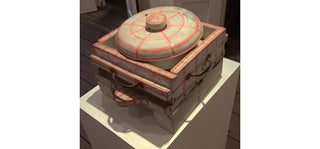It’s a group show, and its central concern is the exploration of abstract drawing, wherein line and structure become fundamental. On display are works by eleven artists, from all backgrounds – outsider art (Zebedee Armstrong) nudges up against established figures like Massimo Bartolini and Tess Jaray. The exhibition’s subtitle, ‘Drawing on abstraction’, explains succinctly in three words what I’ll try to elaborate below.

Share this article
'Tell it slant' at Frith Street's Soho Square
The exhibition’s subtitle, ‘Drawing on abstraction’, explains succinctly in three words what I’ll try to elaborate below.

Zebedee Armstrong, 'Vessel', 1986
It’s a Wednesday afternoon, slouching around Soho, when I fall into Frith Street Gallery to see ‘Tell It Slant’. It’s curated by artist Jeff McMillan, and the exhibition’s title comes from a poem by Emily Dickinson, ’Tell all the truth but tell it slant’.
Armstrong’s pieces, in the centre of each room on the first floor, seemed to me an especially inspired selection, and a good place to start. His works 'Vessel' and 'Cylinder' (both 1986) felt absolutely in harmony with the tone set by the pieces on the wall, despite constituting the only sculpture. Meticulous and sensitive curatorship ensures that the concepts explored in both the 2D and 3D works are consistent; in fact, it’s true that throughout the exhibition each piece adds to the last, like a round rather than competing arias. Nothing feels fractious here, which is a real feat considering the ambitious nature of bringing together so many different artists, and their varied practices and philosophies, in this relatively small space.

Zebedee Armstrong, 'Cylinder', 1986
Tess Jaray‘s geometric compositions sit beautifully with Julius Bockelt’s coloured line drawings. Bockelt was, I think, my favourite new discovery from the exhibition. Some research since I left has cemented that inkling and kindled a sincere admiration. So: since childhood, the artist has been fascinated by, and studied extensively, the physical limits of perception. Vibrations – sound waves – in his work become represented visually, structurally. I’m charmed by the synaesthesia – his marriage of aural and visual – as well as his harnessing of patterns already existent in nature to produce a pattern on a page, artist as elective conduit.
I’m charmed by the synaesthesia – his marriage of aural and visual – as well as his harnessing of patterns already existent in nature to produce a pattern on a page, artist as elective conduit.

Julius Bockelt, 'Untitled', 2006
There’s also an interesting issue of temporality, permanence and transience to think about – the sound which made the waves which inspired, say, 'Untitled 2006', is fleeting. In fact, it’s gone. Its visual translation, however, will last almost indefinitely. What do we memorialise? Bockelt has been variously inspired by soap bubbles and the phenomenon of echo, and his drawings represent an interesting metaphysical transposition as much as they are objects of beauty in their own right. Most touching – perhaps because it implies a respect for the original medium – the work seems to me to be a transcribing, rather than a renarrativising.

Tess Jaray, 'Rise', 2010
Bockelt’s work is a fitting avenue for discussion of the exhibition as a whole. Abstraction, we learn, is often very highly stylised – it is frequently anything but random, and there are nods to mathematics and physics. Waves, geometry, symmetry and tessellation can read cold when represented visually, but become imbued with a new significance when the logic behind their creation is laid bare. Massimo Bartolini’s piece, 'Untitled (airplane)' was another favourite, and also illustrates the potential for harmony, rather than tension, between our conflicting desires for order and freedom.
To create the work, Bartolini folds a large paper aeroplane, unfolds it, and lines the creases left with ink. The finished work constitutes its own blueprint, hovering somewhere between an idea and its realisation.

Massimo Bartolini, 'Untitled (airplane)', 2012
To create the work, Bartolini folds a large paper aeroplane, unfolds it, and lines the creases left with ink. The finished work constitutes its own blueprint, hovering somewhere between an idea and its realisation. There is a way to fold a paper aeroplane. Its folding represents its being ‘finished’. By undoing this sequence and building on the traces its initial execution left on the medium, Bartolini embraces the liminal and produces something between drawing and sculpture.